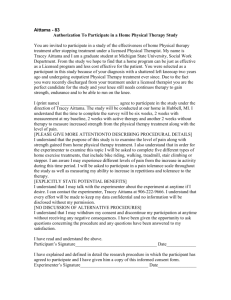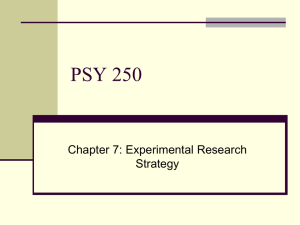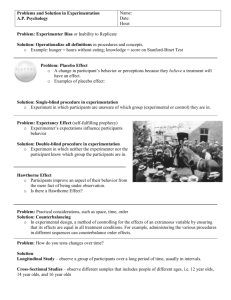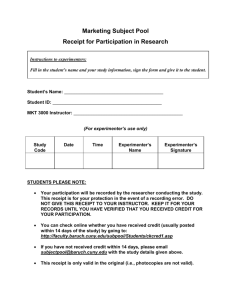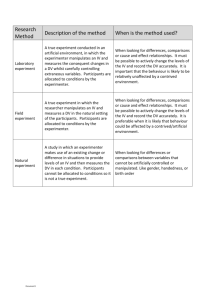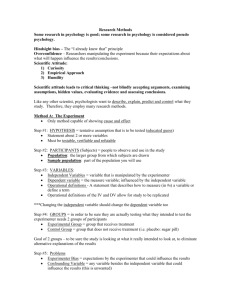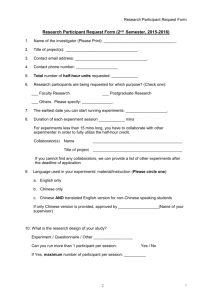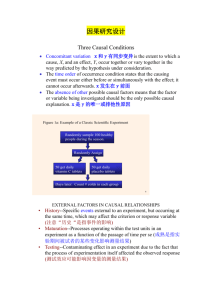Chapter 6 Conducting an Experiment: General Principles
advertisement
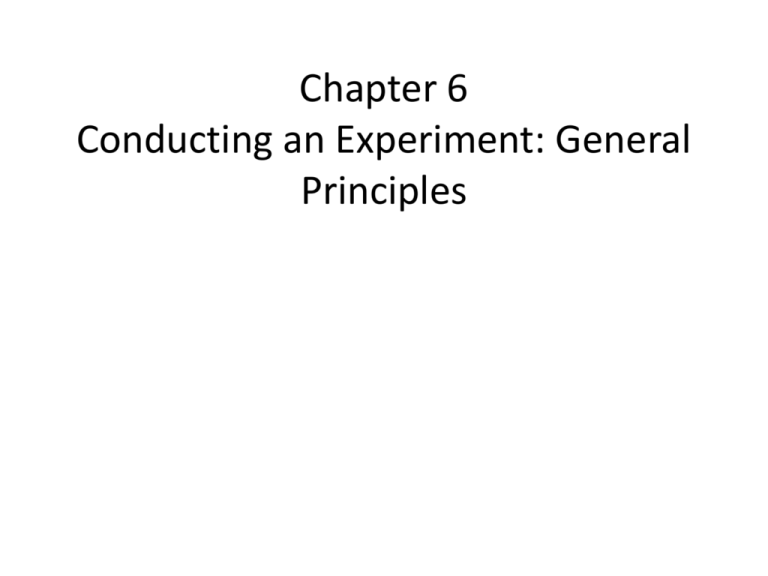
Chapter 6 Conducting an Experiment: General Principles Choosing a Methodology: The Practicalities of Research • What is an experiment? – The researcher creates equivalent groups through random assignment – There is at least one systematically manipulated independent variable – The researcher compares the groups to see if their behavior differs on the dependent variable Determining the Causes of Behavior Requirements for Determining Causation Covariance rule: The two variables have to vary together in a predictable fashion. • This characteristic is correlation, which is necessary, but not sufficient, to identify causes Temporal precedence rule: The causal variable has to precede the effect Internal validity rule: The causal variable must be the most plausible cause, and other causal variables must be ruled out Causal ambiguity: The situation resulting when you cannot identify one and only one plausible causal variable because there are competing variables that could have a causal relation. The Logic of Experimental Manipulation The simplest experimental design Experimental Group that receives the treatment Control Group that does not receive the treatment The Logic of Experimental Manipulation • Experimental Group—The group or groups that receive a treatment. – The simplest experiment has one experimental group, but some experiments have more than one. • Control Group—The group that receives no treatment – The experimental group is compared with the control group • Placebo Group—A group similar to a Control Group but that receives a fake treatment. Ethics in Experimental Clinical Research • People come to clinicians for treatment. • Is it ethical to conduct research by assigning them to conditions that might not actually help them? • Sometimes new treatments are superior, but sometimes they are not. • We rely on researchers’ expertise and external review by a board that reviews ethical issues Controversy: Withholding Treatment in Medical Research • Many medical treatments have not actually been studied in experimental research, so it might be a good idea to see if the treatments actually work. • Experiments are the best way to see if treatments work. – Research has revealed that a number of medical treatments work no better than placebo treatment. Lack of Control in Experimental Research Lack of Control in Experimental Research Extraneous Variables—A variable that the investigator is not studying that may affect the behaviors being studied Confound—A variable not controlled by the experimenter that has a systematic effect on at least one group in the experiment Example of an Extraneous Variable • Researchers found that children who had night lights as infants became nearsighted (myopic) afterward. • When children did not have night lights, they were less likely to show nearsightedness. • Could the presence of night lights have caused the myopia? Example of an Extraneous Variable Incidence of Myopia and Normal Vision Percentage of Nearsighted Patients 70 60 No Night Light 50 Night Light 40 30 20 10 0 Normal Myopic Vision Status Source: Quinn, G. E., Shin, C. H., Maguire, M. G., & Stone, R. A. (1999). Myopia and ambient lighting at night. Nature, 399, 113-114. © Macmillan Magazines Ltd.. Reprinted by permission. Example of an Extraneous Variable • Are there other variables that might be related to nearsightedness? – Nearsightedness is partially hereditary. – Nearsighted parents may need night lights. – Their children may become nearsighted not because of night lights, but because of the genetic inheritance from parents. • Subsequent research showed that night lights are not causally related to nearsightedness; the relation is only correlational. Controversy: Do Women Fear Success? • Research showed that women generated more negative stories to statements like “Joanne found herself at the head of his medical school class” than men did to statements like “John found himself at the head of his medical school class.” • Do the negative stores reflect women’s fear of being successful? Controversy: Do Women Fear Success? • The stories involved paired names (John/Anne) in which the female name was generally associated with negative stereotypes. – When the names were balanced to be equally positive, the difference in negativity of the stories tended to disappear. – It took over two decades to discover this experimental flaw. • Small changes in experimental designs can have big effects. Experimenter Effects • Experimenter Bias—The tendency of researchers to inadvertently affect participants’ behaviors, obscuring the effect of the independent variable Participant Effects • Participants try to figure out what the study is about and may try to “help out” the experimenter by acting “the right way”, which is not good for the study. • Cover story—The researcher can create a story that disguises the purpose of the study. • Blind study – Single blind study—The participants do not know what condition they are in. – Double blind study—Neither experimenters nor participants know what group the participants are in. Participant Effects Types of Participant Effects Hawthorne Effect—The tendency by participants to act differently than normal because they know they are being studied. Demand Characteristics—The tendency by participants to respond to what they think the experimenter wants (or demands) from them. Evaluation Apprehension—The tendency to feel inadequate or to experience unease when being observed. Interaction Effects Between Experimenters and Participants Types of Interaction Effects Between Experimenters and Participants Biosocial effect—Change in participant behavior based on characteristics like age, sex, or race of the experimenter. Psychosocial effect—Change in participant behavior based on supposed attitudes or personality of the experimenter. Realism in Research • Mundane Realism—The characteristic of a research setting such that it resembles a situation in everyday life, rather than an artificial (e.g., laboratory) setting. • Experimental Realism—The characteristic of research such that participants experience the psychological state that the experimenter intends to produce.
